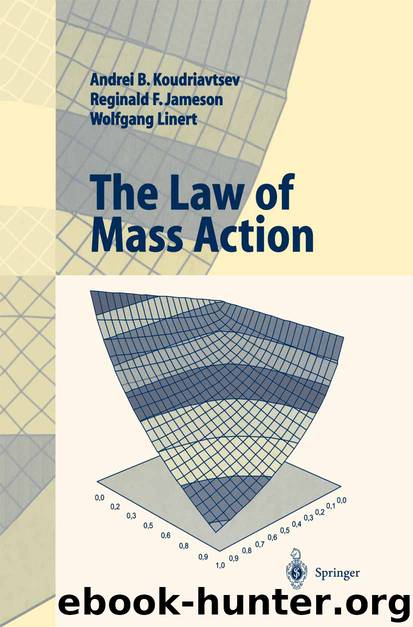The Law of Mass Action by Unknown

Author:Unknown
Language: eng
Format: epub
Publisher: Springer-Verlag Wien 2012
Published: 2015-04-13T16:00:00+00:00
In liquids there is no long-range order, therefore molecular interactions are taken into account in a slightly different way. They are divided into two parts: (i) those with the molecules of the first coordination sphere (described by (5.27)) and (ii) those with all other molecules. The number of nearest neighbours in liquids (the effective coordination number, c) is usually known and their contribution to the total potential energy is Ncφ/2.
The effects of molecules outside the first coordination sphere in liquids are estimated assuming these layers to be a continuum. If the concentration of molecules in a liquid is some constant value4 q = (N/V), then the number of molecules in a spherical layer of the radius r and thickness dr is q4πr2dr. The total energy of interaction of a given molecule with molecules outside the first coordination sphere can be found by integration over the distances from the radius of the border between first and second coordination spheres (R2) to infinitely large distances: (5.32)
Download
This site does not store any files on its server. We only index and link to content provided by other sites. Please contact the content providers to delete copyright contents if any and email us, we'll remove relevant links or contents immediately.
Waking Up in Heaven: A True Story of Brokenness, Heaven, and Life Again by McVea Crystal & Tresniowski Alex(37663)
Empire of the Sikhs by Patwant Singh(22974)
We're Going to Need More Wine by Gabrielle Union(18967)
Hans Sturm: A Soldier's Odyssey on the Eastern Front by Gordon Williamson(18475)
Leonardo da Vinci by Walter Isaacson(13179)
The Radium Girls by Kate Moore(11921)
Tools of Titans by Timothy Ferriss(8215)
Educated by Tara Westover(7939)
How to Be a Bawse: A Guide to Conquering Life by Lilly Singh(7384)
Permanent Record by Edward Snowden(5737)
The Last Black Unicorn by Tiffany Haddish(5558)
The Rise and Fall of Senator Joe McCarthy by James Cross Giblin(5228)
Promise Me, Dad by Joe Biden(5087)
The Wind in My Hair by Masih Alinejad(5033)
A Higher Loyalty: Truth, Lies, and Leadership by James Comey(4842)
The Crown by Robert Lacey(4722)
The Iron Duke by The Iron Duke(4291)
Joan of Arc by Mary Gordon(4013)
Stalin by Stephen Kotkin(3875)
